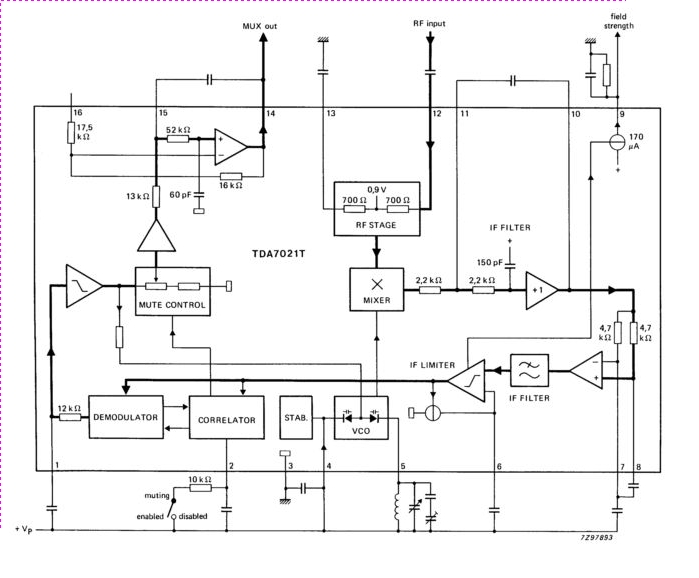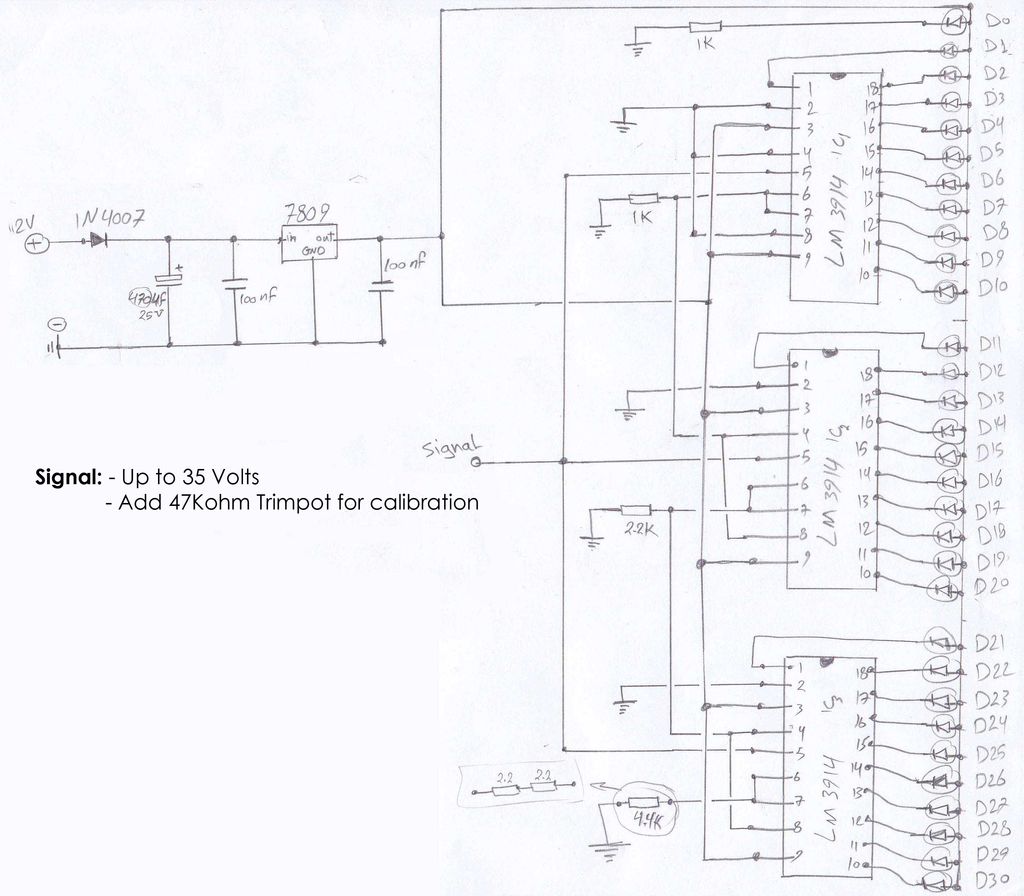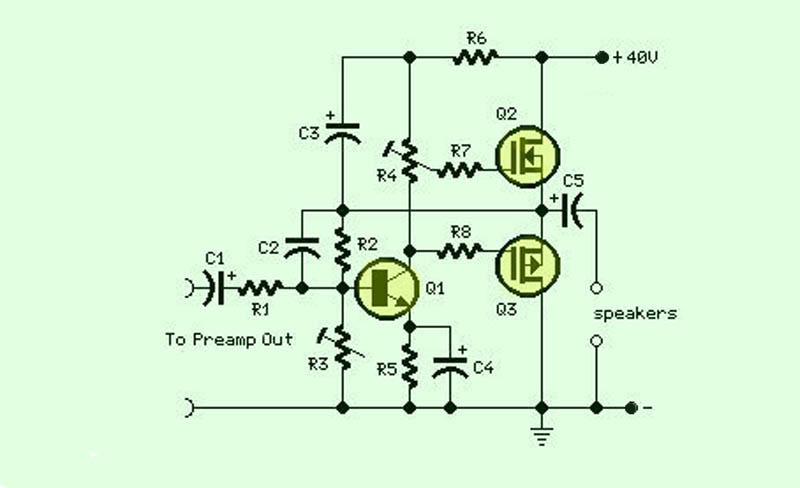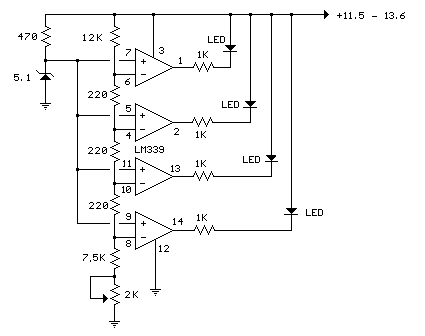
12V Battery Checker Circuit
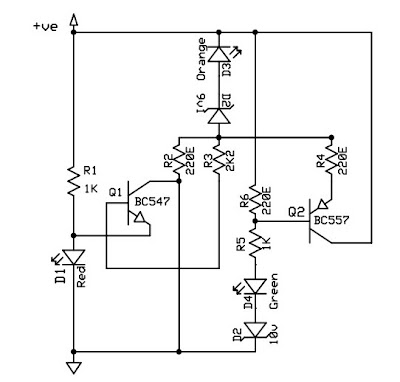
This circuit is a 12V battery checker that utilizes three LEDs to indicate different voltage levels. The red LED illuminates when the battery voltage is between 8V and 10V, the orange LED activates at voltages ranging from 10.5V to 12V, and the green LED lights up when the battery voltage exceeds 12.5V. This battery checker circuit has been validated and employs one NPN and one PNP transistor. A PCB layout is provided along with the schematic.
The 12V battery checker circuit is designed to provide a visual indication of battery voltage levels through the use of three distinct LEDs, each corresponding to specific voltage ranges. The circuit operates by monitoring the voltage of the battery and lighting up the appropriate LED based on the measured voltage.
The red LED serves as a warning indicator, activating when the battery voltage falls within the critical range of 8V to 10V, suggesting that the battery is nearing depletion and requires recharging. The orange LED indicates that the battery voltage is within a moderate range of 10.5V to 12V, suggesting that the battery is still functional but may be approaching the lower end of its operational threshold. Finally, the green LED signifies that the battery voltage is above 12.5V, indicating a healthy battery state.
The circuit employs one NPN transistor and one PNP transistor, which function together to control the LED indicators based on the voltage levels detected. The transistors act as switches that turn the LEDs on or off depending on the voltage at their base terminals, which are connected to a voltage divider circuit that samples the battery voltage.
The printed circuit board (PCB) layout accompanies the schematic, ensuring ease of assembly and reliability. The design is optimized for clarity and efficiency, making it suitable for both hobbyist and professional applications. The use of discrete components allows for straightforward troubleshooting and modification if necessary, while the clear voltage thresholds provide reliable performance in various battery monitoring scenarios.This is a 12V battery checker circuit that uses 3 LEDs that light up at their respective voltages. The red LED lights up when the battery voltage is between 8 to 10V, the orange one at voltages between 10. 5V to 12V and the green one when the battery voltage is above 12. 5V. This is a tried and tested battery checker circuit using one NPN and one PNP transistor. A PCB is given along with the schematic. 🔗 External reference
The 12V battery checker circuit is designed to provide a visual indication of battery voltage levels through the use of three distinct LEDs, each corresponding to specific voltage ranges. The circuit operates by monitoring the voltage of the battery and lighting up the appropriate LED based on the measured voltage.
The red LED serves as a warning indicator, activating when the battery voltage falls within the critical range of 8V to 10V, suggesting that the battery is nearing depletion and requires recharging. The orange LED indicates that the battery voltage is within a moderate range of 10.5V to 12V, suggesting that the battery is still functional but may be approaching the lower end of its operational threshold. Finally, the green LED signifies that the battery voltage is above 12.5V, indicating a healthy battery state.
The circuit employs one NPN transistor and one PNP transistor, which function together to control the LED indicators based on the voltage levels detected. The transistors act as switches that turn the LEDs on or off depending on the voltage at their base terminals, which are connected to a voltage divider circuit that samples the battery voltage.
The printed circuit board (PCB) layout accompanies the schematic, ensuring ease of assembly and reliability. The design is optimized for clarity and efficiency, making it suitable for both hobbyist and professional applications. The use of discrete components allows for straightforward troubleshooting and modification if necessary, while the clear voltage thresholds provide reliable performance in various battery monitoring scenarios.This is a 12V battery checker circuit that uses 3 LEDs that light up at their respective voltages. The red LED lights up when the battery voltage is between 8 to 10V, the orange one at voltages between 10. 5V to 12V and the green one when the battery voltage is above 12. 5V. This is a tried and tested battery checker circuit using one NPN and one PNP transistor. A PCB is given along with the schematic. 🔗 External reference
